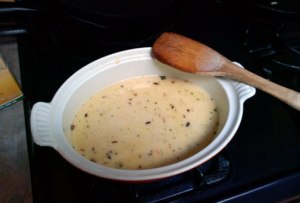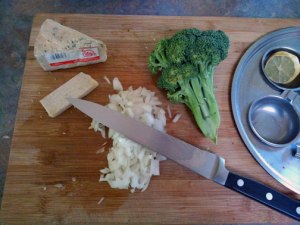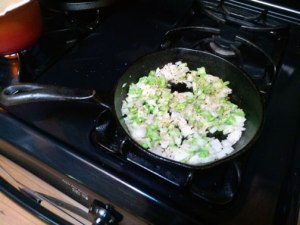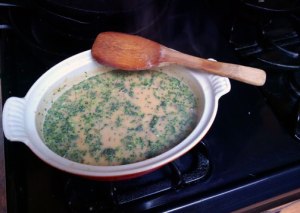Lately there have been several news stories about the effects of wasting food. They have covered the gamut from the economic to the environmental impact. One estimate posits that we dispose of 33 million tons of edible food each year in this country. 33 MILLION tons. That’s more zeroes than I care to think about. Another expert suggests that the moisture in all that food is about two times the volume of Crater Lake.
Now I’m not suggesting that I have a solution to all this waste. I don’t. But what I do have is an idea about how you and I can begin to chip away at it. It’s not a grand and glorious scheme like Trader Joe’s former president Doug Rauch has. Although I do, as our British cousins say, give him full marks for his brilliant idea.
The first thing my simple, personal plan entails is understanding that little date that appears on so many packages of food. It is not always an EXPIRATION date. It’s best to recognize that many times it’s a ‘Sell By:’ date or a ‘Best Used By:’ date. In those cases, there is nothing inherently wrong with eating the food after the date stamped on the package. Sure, if it’s obviously spoiled, like it turns green or that odd shade of pinkish orange, or there’s hair on it, (or worse yet, it actually moves on its own inside the fridge) you are not going to use it. But other than that, it’s fine to consume it. You are going to want to cook it properly but it’s still nutritious food.
Now here’s a shocker. Some ‘spoiled’ foods are still usable, like sour milk. In fact, with a bit of baking soda added to the recipe, it makes the most awesome pancakes you’ll ever eat. Sour cream is, well, sour cream. Even the commercial stuff started out as sweet cream but it had a culture introduced into it to make it curdle and sour. Of course it got a lot of the moisture removed (in the expensive brands) or a lot of gelatin added (in the less expensive brands) but basically, it’s the same thing that you threw out last week.
One other thought. Cheese. Cheese was invented when bacteria were introduced into milk and cream to solidify them and preserve them. The wax on the outside is to deny air to the culture and thereby arrest its continued development. So, cheese is just another form of spoiled milk and cream.
Anyway, I digress, as usual.
Back to my simple plan. Buy what you’re going to use and use what you buy.
Part two of the simple plan involves using what you have in the fridge and cupboard. All too often food ends up in the garbage because we don’t know what to do with it.
- It’s too little to make it a meal by itself.
- I’ve eaten it for the past three days and I’m tired of it.
- I brought it home from the restaurant but now, meh, I don’t really want that.
- Hey, I forgot that in the back of the cheese drawer and it’s all dry.
Whatever. We toss things out that we can retask. You can make some amazing meals out of leftovers and a little creativity. Heaven knows, you must have gotten something out of all those FoodNetwork shows you’ve been watching. Here’s an example.
I was rummaging in the fridge to find something to make for a meal. I found a dollop of chicken stew (originally made from the boiled carcass of a roasted chicken, a few left over roasted potatoes, and a carrot or two – that was leftover makeover #1), a half box of chicken stock, enough broccoli for one person but not two, a dried chunk of cheddar cheese (actually it was ale and mushroom cheddar) and an aging block of Stilton blue cheese.
Now being a fan of BBC programming, I know our British cousins are very fond of broccoli and Stilton soup. After all, I’ve seen it more than once on Midsomer Murders. Bing! The light bulb went on and inspiration took hold. Now, this looks like a recipe, and if you have the same leftovers as I did, you can treat it as such. But really what I want you to do is use it as inspiration. Look at what you have and see if you can’t combine it to make something yummy. Remember, all cooking is an ongoing experiment. Recipes are guidelines at best but more likely just suggestions. We all ‘add in a little of this’ and ‘leave out all of that’ based on our likes, dislikes, taste, etc. Play with your food. If you use a little common sense and occasionally look for some guidance or inspiration, you’ll be amazed at how often it comes out wonderfully.
Last plug here. Check out this Tumblr link. It’s based on a segment that NPR runs called Cook Your Cupboard. It helps regular folks like us find inspiration and guidance from celebrity chefs and food experts when it comes to using those things we impulsively bought because they “looked interesting.” It’s a lot of fun and it may also inspire you to play with your food more.
Happy cooking!
BACK OF THE FRIDGE BROCCOLI AND STILTON SOUP
- 1 stalk of broccoli (semi to mostly wilted)
- 1 gob o’ leftover chicken stew. (only fills ¼ of the container and yet takes up half the shelf)
- The dicey half of an onion from the bottom of the pantry basket that is in serious danger of going completely off
- 1 clove of garlic (HEY! A fresh ingredient! What’s that doing here?)
- 1 chunk dried cheddar cheese. (Okay, it’s the right size and so dry you could use it to shim up that wobbly table in the hall but, let’s get radical and cook it instead)
- 1 chunk dicey Stilton or other blue cheese. (This brings up a question. How does one know when blue cheese or a ripe cheese ‘goes off’? I mean, they’re either moldy or stinky to begin with, right?)
- The scrapings of the bottom of the container of sour cream. (I’m pretty sure there were about two Tablespoons in there)
- ½ box of chicken broth that has been on the door shelf for a couple of days now. (about 2 cups)
- About 1 teaspoon of butter or ghee
- Salt and pepper to taste
- About 20 grinds of Trader Joe’s Everyday Seasoning (If you’ve been reading the blog, you’ll start to notice a theme about now)
Trim the florets from the limp broccoli and set them aside for later use. Don’t throw out the stems. Instead, chop them into a ⅛ inch mince and combine with the onion and garlic. (Do throw away the dicey, soft, yellowish gonna spoil on you any minute part of the onion. NOTE: you can make a composter even on a patio or balcony. Vegetable waste becomes soil and does not smell when it’s done correctly. Trust me, it’s not that hard. Great for potted plants and even house plants.) If the broccoli stems are ‘woody’ you can peel them with a vegetable peeler and just use the inner pulp. Lots of flavor there!
In your soup pot, melt the butter or ghee (I prefer ghee, it doesn’t burn like butter but gives you that good butter flavor). Add the minced vegetables, TJ’s seasoning, salt and pepper. Sauté over medium low heat until onion and garlic just begin to color.
Pour in the chicken stock and add the stew and sour cream. (I first removed and diced the potatoes up into tiny bits. This way, although very few, they are found throughout the soup and add nice texture. I like textured soups.

Seasoned broth and veggie mixture. Okay, I’m sorry, I did the veggies in a different pan but it still comes out well.
Grate the cheeses together and slowly stir into the broth/stew/vegetable mixture. Once it is dissolved, it’s decision time.
Like I said, I like chunky soups. Not everyone does. If you prefer a smoother soup, take the hot broth mixture and carefully pour it into a blender or food processor. Blend or pulse until the desired smoothness. Return to the pot and continue cooking.
Again, I like texture so I like my veggies kind of ‘al dente’. Some people prefer their broccoli well cooked. I don’t understand it but I accept it. So, we have another decision point here.
Remember the limp broccoli florets? If you like a smooth soup, toss them into the food processor. (You didn’t clean it out yet, did you? No? Good. ) Scrape the broccoli dust into the soup and stir it in.
If you prefer your broccoli to have that ‘just steamed’ flavor, simmer the soup for about 3 – 4 minutes and then serve. If you prefer it cooked a bit more, let it simmer for about 10 minutes.
If you are a texture person, roughly chop the florets and pile them into the soup. Again, decide on the doneness you like and cook accordingly before serving.
That’s it. Simple, tasty, uses up all kinds of leftovers, and it’s ready in about 30 minutes from chop to serve because everything in it is already pretty much cooked.



